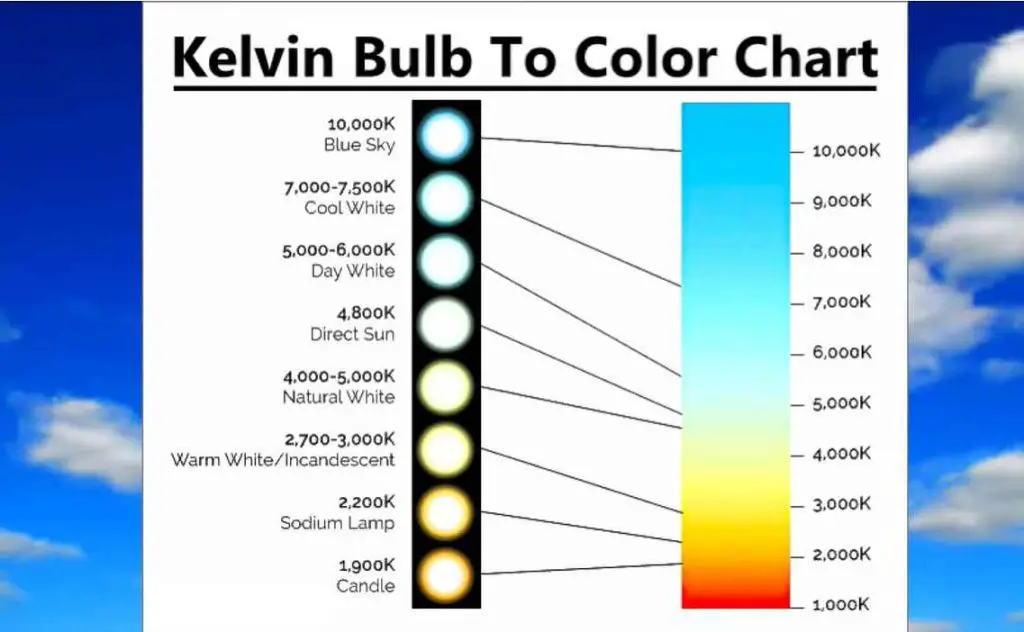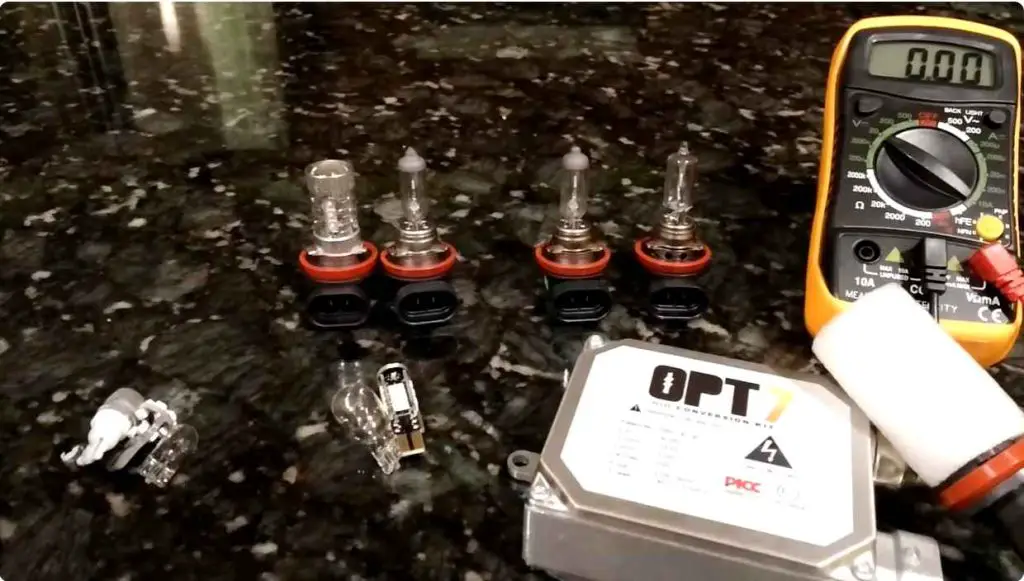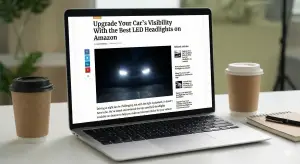A typical halogen headlight draws about 4.5 to 5.5 amps. This consumption can vary slightly based on the headlight’s wattage and vehicle system voltage.
Selecting the right halogen headlight for your vehicle involves comprehending not only the model and fit but also how much electrical current it requires. With most cars operating on a 12V system, it’s important to know the ampere draw to maintain your vehicle’s electrical balance and ensure safety.
How Many Amps Does a Halogen Headlight Draw? The typical 55-watt halogen bulb, for example, will draw about 4. 5 amps—which is a calculation based on Ohm’s Law, dividing the wattage by the system voltage (55 watts/12 volts = 4. 58 amps).
Properly functioning headlights are important not just for night-time visibility but also to pass inspections and avoid potential traffic violations. Regular checks can help keep your car’s lighting system in top condition, preventing unexpected failures on the road.
Introduction To Halogen Headlights
Introduction to Halogen Headlights: When darkness falls, car headlights become your guiding lights on the road. Among the various types of headlights, halogen ones shine bright for many drivers.
Known for their luminosity and efficiency, halogen headlights continue to be a popular choice, even with newer technologies available. Their simplicity and cost-effectiveness play a significant role in their widespread use. But how much power do they consume? Let’s illuminate the subject.

The Basics Of Halogen Headlight Technology
Halogen headlights work like your home’s incandescent bulbs but with a twist. These tiny bulbs pack a punch with halogen gas that allows them to glow brighter and last longer than standard bulbs.
The clear outer glass envelops a filament and halogen gases, lighting up the road efficiently. When activated, they draw current from the car’s battery, measured in amps, to produce their bright white light.
Comparing Halogen To Led And Hid Headlights
Each headlight type has its pros and cons. Halogens are the go-to choice for their warmth and affordability. On the other hand, LEDs boast low power consumption and long life spans.
HIDs step up with intensive brightness, yet they come at a higher cost and can be too glaring in some scenarios. To understand better, here’s a comparison:
| Headlight Type | Average Lifespan | Average Power Draw (Amps) | Brightness (Lumens) |
|---|---|---|---|
| Halogen | 450 – 1,000 hrs | 4.5 – 5.5 A | 1,000 – 1,500 lm |
| LED | 15,000 – 25,000 hrs | 1.5 – 2.5 A | 2,000 – 3,000 lm |
| HID | 2,000 – 5,000 hrs | 3.5 – 4.5 A | 3,000 – 5,000 lm |
Mastering Electrical Measurements
Comprehending Electrical Measurements is essential when handling vehicle maintenance or upgrades, such as replacing halogen headlights. Knowing how many amps a headlight draws helps ensure compatibility and safety. Let’s explore this with a focus on amperage and its relationship with other electrical units.
Defining Amperage And Its Relevance To Headlights
Amperage, or current, measures the flow of electricity. In terms of headlights, it signifies how much electrical current passes through the bulb. This affects the bulb’s brightness and durability. A higher current can lead to brighter light but may also cause quicker wear.
Relation Between Watts, Volts, And Amps
The power of headlights is often rated in watts. Yet, watts tell only part of the story. To fully understand, consider the electrical formula: Power (Watts) = Voltage (Volts) x Current (Amps).
- Voltage: The electrical potential or pressure.
- Current: The flow rate of electric charge in amperes.
- Power: The rate at which energy is consumed, in watts.
To find out the amps a halogen headlight draws, divide the wattage by the voltage of the vehicle’s electrical system. A common car voltage is 12 volts.
| Headlight Wattage | Vehicle Voltage (V) | Current (Amps) |
|---|---|---|
| 60 Watts | 12 Volts | 5 Amps |
| 55 Watts | 12 Volts | 4.58 Amps |
This table showcases examples of different wattages and the resulting amperage for a typical halogen headlight.
Standard Halogen Headlight Specifications
Grapsing standard halogen headlight specifications is key for car maintenance. Headlight power draws can impact the vehicle’s electrical system. Halogen bulbs are common and have set ratings. Let’s explore these ratings and learn about the amps they draw.

Common Wattage Ratings For Halogen Bulbs
The bulb’s wattage determines the amps drawn. Below are typical wattages for halogen headlights:
- 55 Watts – Standard for many cars.
- 65 Watts – Found in some high-beam bulbs
- 100 Watts – For off-road or auxiliary lights
Calculate amps by dividing the wattage by the system’s voltage. For example, a 55-watt bulb in a 12-volt system draws about 4.6 amps.
Voltage Specifications Of Vehicle Electrical Systems
Vehicles typically run on a 12V DC supply. This is vital when calculating the current drawn by the headlights. Remember:
| Vehicle Type | Voltage Supply |
|---|---|
| Most cars, motorcycles, and light trucks | 12 Volts |
| Heavy trucks and buses | 24 Volts |
For accurate amp calculations, always use the vehicle’s voltage specification.
Calculating The Amperage Draw Of Halogen Headlights
Insighting the amperage draw of halogen headlights is important for vehicle owners. It affects the electrical system’s performance. Knowing the draw helps prevent battery drain. This guide simplifies the process of calculating your vehicle’s halogen bulb amperage draw.
Formula For Determining Amperage
The formula “Amperage (A) = Watts (W) / Volts (V)” calculates electrical current draw. Halogen headlights typically operate on 12 volts in most vehicles. To find the amperage draw, divide the wattage rating of the bulb by 12 volts.
Example Calculations For Different Halogen Bulb Ratings
Consider two common halogen bulb ratings:
- 55W bulbs: A popular choice for many vehicles.
- 65W bulbs: Offer brighter light but draw more power.
| Bulb Rating (W) | Vehicle Voltage (V) | Amperage Draw (A) |
|---|---|---|
| 55W | 12V | 4.58A |
| 65W | 12V | 5.42A |
To calculate these values:
- Divide 55W by 12V, resulting in 4.58A for 55W bulbs.
- Divide 65W by 12V, resulting in 5.42A for 65W bulbs.
Use these calculations to ensure your vehicle’s electrical system can handle the bulb’s power requirements.
Factors Affecting Halogen Headlight Amperage
Mastering the amperage draw of halogen headlights is critical for vehicle safety and functionality. A variety of factors influence how much current these lights use. Knowing these can help maintain optimal performance. Let’s explore these factors in detail.
Impact Of Headlight Design On Amp Draw
Halogen headlights come in different shapes and sizes. Their design can affect the power they require. Here are key design elements to consider:
- Bulb Wattage: Higher-wattage bulbs draw more amps.
- Reflective Coating: Efficient designs may need less power.
- Lens Material: The lens can affect light output and power usage.
Single vs. Dual Filament: Dual filament bulbs, used for both high and low beams, might draw more current when both filaments are active.
The Influence Of Wiring And Circuitry
The electrical setup in your vehicle plays a vital role in the amperage draw of your headlights. Here’s how:
- Wire Gauge: Thicker wires carry more current efficiently.
- Corrosion Resistance: Corrosion-free connections ensure proper current flow.
- Relay Use: Relays can reduce the draw through the switch.
It’s important to use the right wiring and maintain it well. This helps prevent excessive draw that can blow fuses or dim your lights.

Real-world Measurements
Knowing how many amps a halogen headlight draws is key for car maintenance. It ensures headlights work properly without overloading the electrical system. Precise measurements offer the insights needed to maintain optimal performance. This section dives into hands-on methods for measuring a halogen headlight’s amp draw.
Tools For Measuring Electrical Draw
To measure a halogen headlight’s amp draw accurately, you need the right tools. A reliable digital multimeter is essential. This device will help you quantify the current flowing through the headlight’s circuit. To get started, make sure the multimeter is capable of measuring amperage accurately.
| Equipment | Purpose |
|---|---|
| Digital Multimeter | Picks up the headlight’s current rating. |
| Fuses | Protects the multimeter from any potential surge. |
| Headlight Spec Sheet | Provides manufacturer’s amp rating for reference. |
Step-by-step Guide To Measuring A Halogen Headlight’s Amp Draw
With your tools ready, follow these steps to measure the amp draw:
- Turn off your vehicle and open the hood.
- Locate the halogen headlight assembly.
- Use the vehicle’s manual to find the headlight’s wiring.
- Connect the digital multimeter’s positive lead to the headlight’s positive wire.
- Attach the multimeter’s negative lead to a ground point on the vehicle.
- Turn on your vehicle’s headlights.
- Read the multimeter display for the current measurement in amps.
- Compare the reading to the manufacturer’s spec sheet to ensure proper drawing.
Taking these measurements provides a clear view of your halogen headlight’s electrical draw. It allows you to make informed decisions about upgrades or replacements. Regular checks can prevent electrical issues and keep your vehicle’s lighting system optimal.
Efficiency And Performance
Exploring the Efficiency and Performance of Halogen Headlights prompts us to consider two critical aspects: how much energy these bulbs consume and how they perform compared to other technologies. The amps drawn by a halogen headlight are a tangible measure of its power usage, directly impacting both efficiency and on-road effectiveness.
Energy Efficiency Of Halogen Bulbs
Halogen bulbs, widely used in automotive lighting, are known for their brilliance and instant output. Regarding energy consumption, a typical halogen headlight bulb draws between 4.5 to 5.5 amps when operating at a standard 12-volt power supply. This translates to a power usage of approximately 55 to 65 watts. While this is effective for lighting, it is not the most energy-efficient option available.
- Halogens generate heat, losing energy that could turn into light.
- Longevity is average, meaning more frequent replacement and resource use.
- Improved designs have increased efficiency over past versions.
Comparative Performance: Halogen Vs. Alternatives
Comparing halogen headlight bulbs with alternatives like LEDs and HID (High-Intensity Discharge) lamps highlights significant differences. Let’s examine the essentials.
| Light Source | Average Amp Draw | Energy Use (Watts) | Lifespan (Hours) |
|---|---|---|---|
| Halogen | 4.5 – 5.5 | 55 – 65 | 450 – 1,000 |
| LED | 1.5 – 3 | 18 – 36 | 15,000 – 50,000 |
| HID | 3 – 4 | 35 – 42 | 2,000 – 5,000 |
Halogens are outperformed by LEDs and HIDs in terms of energy efficiency and lifespan. LEDs, for instance, require roughly 70% less energy and last significantly longer, offering both economic and environmental advantages. HIDs, while more energy-demanding than LEDs, still offer superior brightness and endurance over halogens.
- LEDs ensure greater savings and reduced maintenance.
- HID bulbs shine brighter for high-performance needs.
- Halogens remain a cost-effective initial choice with moderate output.
Choosing between these options depends on the driver’s preference for brightness, energy conservation, and willingness to invest in longer-lasting technology.
Troubleshooting High Amperage Issues
When your halogen headlights draw too much power, it’s key to find out why. High amperage can cause fuses to blow or wiring to overheat. Comprehending how many amps your headlights should draw helps you find the trouble. This part helps you fix high-amperage problems.
Common Causes Of Excessive Amperage Draw
Listed below are reasons why halogen headlights might use more amps:
- Bad Ground Connection: A weak ground causes resistance; thus, amps go up.
- Worn Out Wiring: Old wires can’t carry current well, forcing the amps higher.
- Faulty Headlight Relay: If this part breaks, it can send too many amps to the lights.
- Incorrect Bulb: The wrong bulb might draw more power than the system allows.
Solving Amperage Problems In Halogen Headlights
Here’s how you can fix high-amperage issues step-by-step:
| Inspection Task | Action |
|---|---|
| Inspect the Grounds | Ensure each ground wire is firm and rust-free. |
| Check the Wiring | Look for damaged or worn wires; replace as needed. |
| Test the Relay | Utilize a multimeter to check the relay; replace if necessary. |
| Verify the Bulbs | Confirm bulbs match headlight specs; change if incorrect. |
By following these steps, you can narrow down the issue. Always handle electrical parts with care. If in doubt, seek a professional mechanic’s help.

Safety Concerns And Precautions
Insighting the amperage draw of halogen headlights is important. It ensures they function safely within a car’s electrical system. A typical halogen headlight can draw between 4 to 5 amps. Yet, this can vary depending on the wattage and vehicle make.
Risks Associated With High Amperage
High amperage can pose several risks:
- Electrical system overload could result in a fire.
- Fused bulbs are possible if the current exceeds the design limit.
- Damage to headlight circuits may occur, leading to costly repairs.
Preventative Measures For Headlight Safety
To prevent these issues, follow these steps:
- Check the car’s manual for the correct amp rating.
- Use quality bulbs and fuses to match your vehicle’s specifications.
- Inspect wiring regularly for any signs of wear or damage.
Professionals can ensure proper installation and maintenance. This will result in safe and effective lighting for your vehicle.
Improving Halogen Headlight Efficiency
Want to make your car’s halogen headlights better? You might be surprised at how much power they need. Knowing this can help you make smart changes. Keep reading to learn easy steps for better headlights.
Tips For Reducing Amperage Draw
Halogen headlights can use a lot of energy. But you can lower this. Here’s how to help your car and your wallet.
- Check the wiring: Old wires can cause more power use. Make sure they’re in good shape.
- Proper alignment: Headlights pointed in the right direction use less power. Get them checked.
- Turn off when not needed: Save power by turning the lights off when you don’t need them.
Upgrading To More Efficient Halogen Bulbs
Not all halogen bulbs are the same. Some new ones use less power and give more light. Here are tips to find them:
- Look for higher efficiency ratings: Bulbs with better ratings will use less power.
- Choose the right wattage: Using the correct wattage can decrease power use.
- Quality brands matter: Pick bulbs from known brands. They often perform better.
The Future Of Headlight Technology
As we look ahead, headlight technology continues to evolve. Brighter, more efficient headlights are on the rise. They help drivers see better and reduce energy use. Traditional halogen headlights draw a significant amount of power. Usually, they range between 4.5 to 5.5 amps. But new advancements are changing the game.

Developments In Halogen Technology
Despite being a longstanding choice, halogen technology isn’t static. Recent improvements include:
- Better filament materials that last longer
- Advanced gas mixtures for brighter light
- Finer bulb designs to improve focus and clarity
Such enhancements mean halogen headlights require less power. They draw fewer amps while delivering excellent visibility.
Emerging Alternatives And Innovations
Beyond halogens, other technologies are entering the spotlight:
| Type | Benefits | Average Amp Draw |
|---|---|---|
| LED | Energy-efficient, long-lasting | 2 to 3 amps |
| HID/Xenon | Powerful, white light | 3.5 amps |
| Laser | Exceptional range, precision | Varies |
Such innovations promise brighter, smarter headlights. They use fewer amps and tout a host of features. Adaptive lighting and automated control are part of these advancements. This technology tailors light patterns to road conditions. It helps drivers and saves power.
Frequently Asked Questions For How Many Amps Does A Halogen Headlight Draw
How Many Amps Does A Halogen Light Use?
A halogen light’s amperage varies by wattage; a typical 50-watt bulb uses about 0. 42 amps at 120 volts. For precise values, consult the bulb’s specifications.
How Many Amps Does A Headlight Bulb Draw?
A typical halogen headlight bulb draws about 4. 5 to 5. 5 amps. LED bulbs usually require less, about 1. 5 to 3 amps, due to their efficiency.
How Many Amps Does A 55 Watt Halogen Bulb Draw?
A 55-watt halogen bulb draws approximately 4. 58 amps on a 12V circuit. For a standard 120V circuit, it draws about 0. 46 amps.
How Much Power Does A Halogen Bulb Use In Car?
A typical halogen bulb used in cars consumes between 40 to 70 watts of power.
Conclusion
Understanding your vehicle’s electrical needs is essential, and halogen headlights are no exception. Typically, a standard halogen bulb draws between 4 to 5 amps of current. Keeping this in mind ensures your car’s electrical system operates smoothly. For optimal performance and safety, regular check-ups are advisable.
Remember, efficient lighting is key to a well-lit journey.



